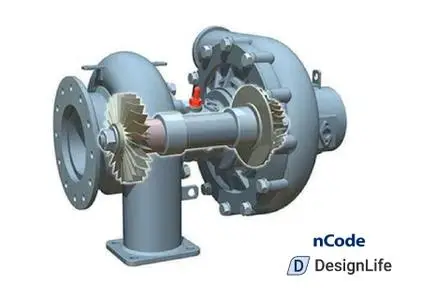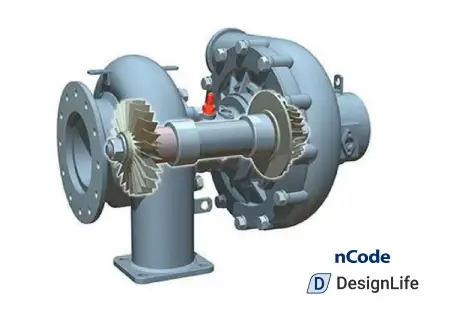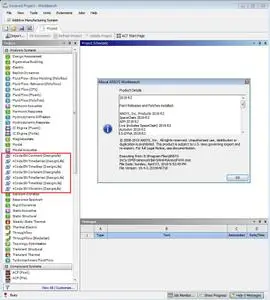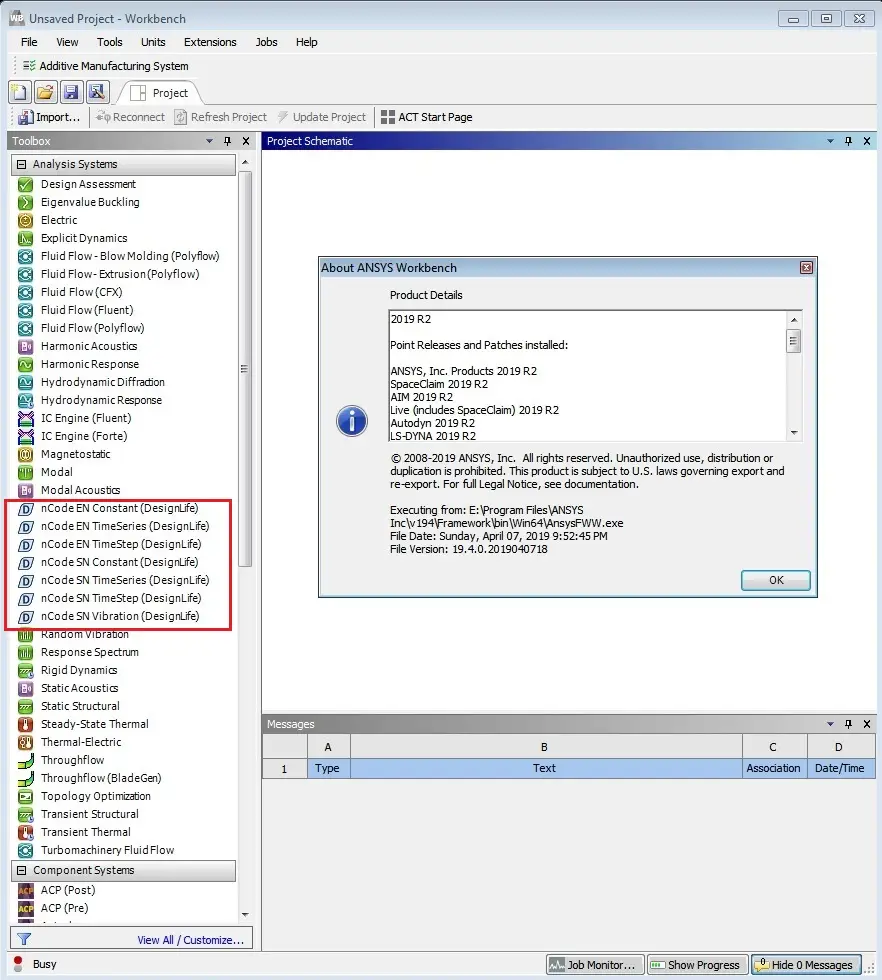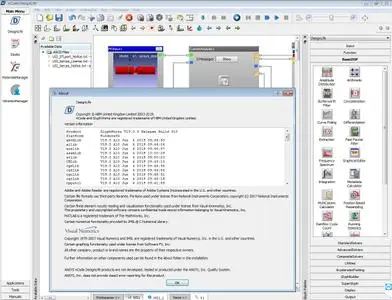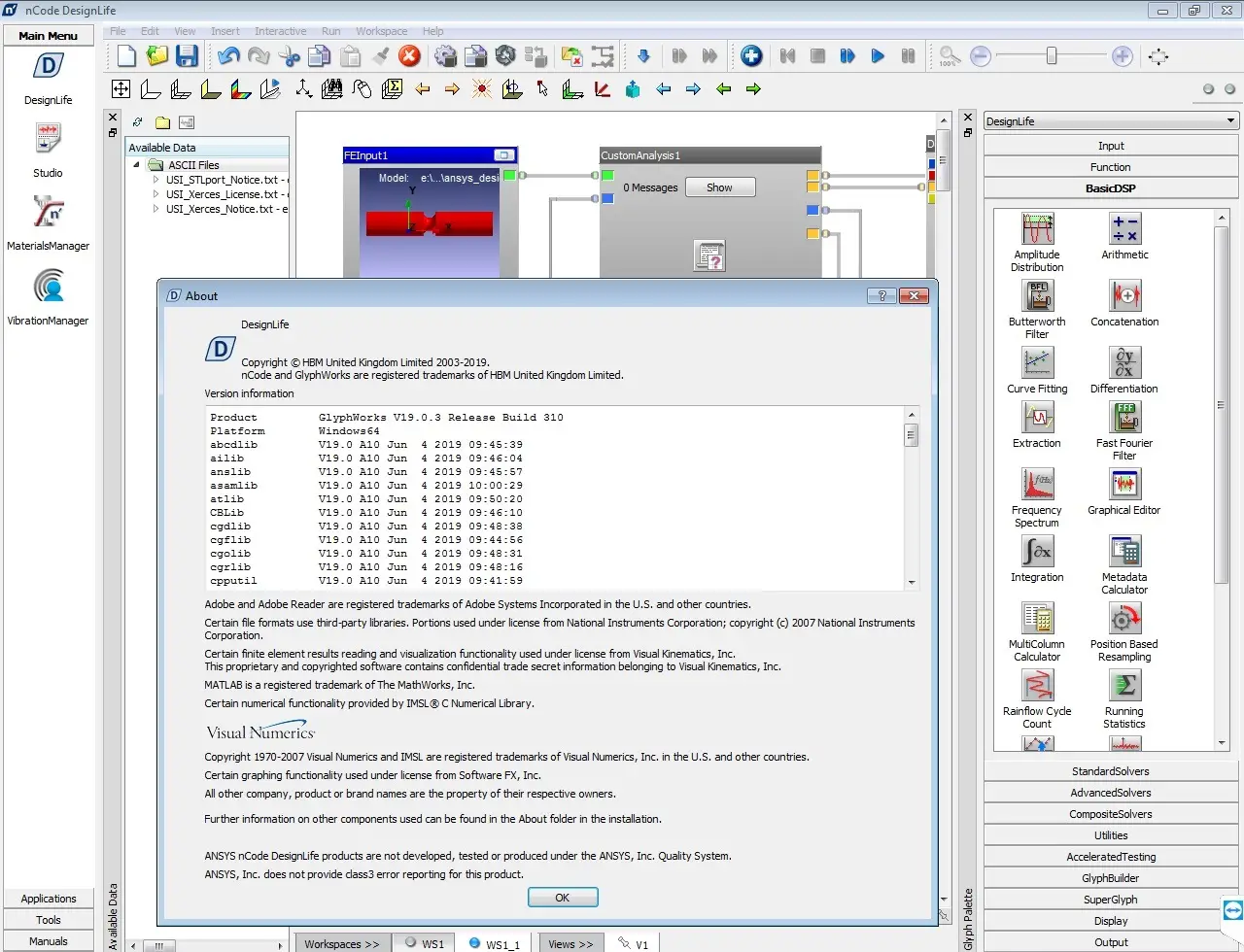ANSYS 2019 R2 nCode DesignLife | 2.9 Gb
HBM, a wholly-owned subsidiary company of Spectris plc, a group specialized in precision instrumentation and electronic controls, announced the release of ANSYS 2019 R2 nCode DesignLife, the leading brand for engineering data analysis solutions with special concentration in fatigue and durability.
DesignLife - New Features
Large displacements between load cases
A new property LargeDisplacements has been added to FEImport analysis group. If set to True, the FE translation will take account of large displacements in the model by calculating the nodal surface normal and local coordinate systems based on the displaced node coordinates.
Rainflow load provider
A new type of load provider is available, that can be used when the input data to a fatigue analysis is, at source, in the form of a rainflow histogram of cycle counts. The rainflow load provider allows this data to be used directly, without the need to construct a time series as input to the CAE Fatigue glyph and then cycle-count that time series within the glyph. The rainflow load provider may only be used with an SN analysis engine.
DesignLife – Enhancements
Group selection via the material map
The user may now control the selection of FE groups via the material map. The user must specify a BoM file in a material map loader and the groups listed in the material group column of the file will be added to the analysis.
SeamWeld vibration with Multi-PSD loading
Multi-PSD loading is now supported for seam weld vibration analysis.
SN 4 Parameter Materials
The SN analysis engine now supports materials defined using a 4-parameter method.
Axisymmetry using the X or the Z axis
Previously, DesignLife could only analyse models represented by axisymmetric elements if the axis of symmetry was the Y axis. The user can now choose between the X, Y and Z axes by setting the SymmetryAxis property of the FE Import Analysis Group object.
Support for PAMCrash erfh5 FE results
Previously, DesignLife only had Beta support for PAMCrash results. PAMCrash erfh5 results files are now supported. Support is currently limited to linear/non-linear stress/strain, vibration (from FRF).
Shear Stress calculation for Seam Weld analysis from force/moment results
DesignLife now optionally calculates the shear stress from force moment results (EntityDataType=ForceMoment or ForceVibration) for use in Seam Weld analysis
Back Calculation Enhancements
The performance of a back calculation with a critical plane combination method has been improved significantly. Now, generally only a single back calculation is performed per entity using the known critical plane angle and damage value from a pre-existing forward calculation (except if all the planes are “Beyond Cut- off” in the forward calculation). The output also shows only the results for the angle with the greatest damage value.
Grey Iron Calculation speed
The performance of the grey iron EN calculation has been improved significantly
Safety Factor Analysis Engine
The safety factor analysis engine can now carry out critical plane analysis with 3D stress results and can now use the Haibach small cycle correction.
NX Nastran SOL601 and MSC Nastran SOL400
DesignLife now supports stress results from these non-linear analyses for use as a linear stress
DesignLife - Other
Medina BOF File Export Removed
Medina BOF file output is no longer available from the FEOutput Glyph.The Export BOF post processor is also no longer available through Advanced Edit on CAE fatigue Glyphs.
GlyphWorks
GlyphWorks - New Features
Python 3.6 Support Added
The support for Python has been extended to include Python 3.6. Prior to this the software only supported Python 2.7. We now have a preference that can be set to either “Python2.7” or “Python 3.6”. The software will then be configured to look for that version of Python on the target machine. This generally requires a full installation of that particular version to be available on the target machine. A new document called Using python in nCode is distributed with the software and describes further details.
B&K BKC file format support
Reading of the B&K BKC file format is now supported on Windows. Not all data types are supported, but various time series channels, and some types of histogram channels which contain a single two-dimensional histogram, can now be read into GlyphWorks.
Dewetron DMD file format support
Reading of the Dewetron DMD file format is now supported on Windows. We currently only support single dimension floating point channels which are imported as time series data. Any of these channels with multiple “sweeps” are imported as multiple runs.
Zoom and Pan of the workspace
The workspace may now be zoomed using Ctrl + mouse wheel or F2 + mouse wheel and panned using Ctrl + right mouse button or F2 + right mouse button.
GlyphWorks - Enhancements
XY Display cross shaped cursors
A new ‘CrossShapedCursors’ preference for the XY Display allows switching between the usual straight vertical or horizontal line, and the new cross shaped cursor mode where the cursor is shown as a cross on the data line.
XY Display cursor labels
A new ‘verbose cursor labels’ checkbox on the ‘Cursors’ dialog box allows the cursor labelling to be switched between the usual cursor name with position and, where appropriate, data values, and the new more compact label which only includes the cursor name.
More options for the label source property in XY Display
More options are now available for the label source property which specifies what text to show for the channel title above a plot. The channel name and data title can now be shown with or without the test name.
Display control summaries added and updated
New ‘control summary’ toolbar options have been added to the Campbell Plot and Histogram displays. Control summaries for other displays were updated to improve consistency
New options to pan and zoom the Studio display window
New options have been added to pan or zoom the Studio display window using the mouse in combination with the keyboard, along with a new ‘control summary’ toolbar button to display them
MATLAB Support - MATLAB R2018b
We now support MATLAB R2018b on supported nCode Windows 64-bit platforms.
SIE meta data support extended
Several more items of meta data are now read when reading an SIE file. Specifically any meta data tags that were associated with the file at the top level or values relating to the acquisition setup used are now read in.
Kyowa ks2 file format support improved
The Kyowa ks2 file format is now supported up to version 1.06
Rainflow rebinning added to Histogram Manipulation glyph
The rainflow rebinning functionality from the Rainflow module is now available in the Histogram Manipulation glyph.
Large displacements between load cases
A new property LargeDisplacements has been added to FEImport analysis group. If set to True, the FE translation will take account of large displacements in the model by calculating the nodal surface normal and local coordinate systems based on the displaced node coordinates.
Rainflow load provider
A new type of load provider is available, that can be used when the input data to a fatigue analysis is, at source, in the form of a rainflow histogram of cycle counts. The rainflow load provider allows this data to be used directly, without the need to construct a time series as input to the CAE Fatigue glyph and then cycle-count that time series within the glyph. The rainflow load provider may only be used with an SN analysis engine.
DesignLife – Enhancements
Group selection via the material map
The user may now control the selection of FE groups via the material map. The user must specify a BoM file in a material map loader and the groups listed in the material group column of the file will be added to the analysis.
SeamWeld vibration with Multi-PSD loading
Multi-PSD loading is now supported for seam weld vibration analysis.
SN 4 Parameter Materials
The SN analysis engine now supports materials defined using a 4-parameter method.
Axisymmetry using the X or the Z axis
Previously, DesignLife could only analyse models represented by axisymmetric elements if the axis of symmetry was the Y axis. The user can now choose between the X, Y and Z axes by setting the SymmetryAxis property of the FE Import Analysis Group object.
Support for PAMCrash erfh5 FE results
Previously, DesignLife only had Beta support for PAMCrash results. PAMCrash erfh5 results files are now supported. Support is currently limited to linear/non-linear stress/strain, vibration (from FRF).
Shear Stress calculation for Seam Weld analysis from force/moment results
DesignLife now optionally calculates the shear stress from force moment results (EntityDataType=ForceMoment or ForceVibration) for use in Seam Weld analysis
Back Calculation Enhancements
The performance of a back calculation with a critical plane combination method has been improved significantly. Now, generally only a single back calculation is performed per entity using the known critical plane angle and damage value from a pre-existing forward calculation (except if all the planes are “Beyond Cut- off” in the forward calculation). The output also shows only the results for the angle with the greatest damage value.
Grey Iron Calculation speed
The performance of the grey iron EN calculation has been improved significantly
Safety Factor Analysis Engine
The safety factor analysis engine can now carry out critical plane analysis with 3D stress results and can now use the Haibach small cycle correction.
NX Nastran SOL601 and MSC Nastran SOL400
DesignLife now supports stress results from these non-linear analyses for use as a linear stress
DesignLife - Other
Medina BOF File Export Removed
Medina BOF file output is no longer available from the FEOutput Glyph.The Export BOF post processor is also no longer available through Advanced Edit on CAE fatigue Glyphs.
GlyphWorks
GlyphWorks - New Features
Python 3.6 Support Added
The support for Python has been extended to include Python 3.6. Prior to this the software only supported Python 2.7. We now have a preference that can be set to either “Python2.7” or “Python 3.6”. The software will then be configured to look for that version of Python on the target machine. This generally requires a full installation of that particular version to be available on the target machine. A new document called Using python in nCode is distributed with the software and describes further details.
B&K BKC file format support
Reading of the B&K BKC file format is now supported on Windows. Not all data types are supported, but various time series channels, and some types of histogram channels which contain a single two-dimensional histogram, can now be read into GlyphWorks.
Dewetron DMD file format support
Reading of the Dewetron DMD file format is now supported on Windows. We currently only support single dimension floating point channels which are imported as time series data. Any of these channels with multiple “sweeps” are imported as multiple runs.
Zoom and Pan of the workspace
The workspace may now be zoomed using Ctrl + mouse wheel or F2 + mouse wheel and panned using Ctrl + right mouse button or F2 + right mouse button.
GlyphWorks - Enhancements
XY Display cross shaped cursors
A new ‘CrossShapedCursors’ preference for the XY Display allows switching between the usual straight vertical or horizontal line, and the new cross shaped cursor mode where the cursor is shown as a cross on the data line.
XY Display cursor labels
A new ‘verbose cursor labels’ checkbox on the ‘Cursors’ dialog box allows the cursor labelling to be switched between the usual cursor name with position and, where appropriate, data values, and the new more compact label which only includes the cursor name.
More options for the label source property in XY Display
More options are now available for the label source property which specifies what text to show for the channel title above a plot. The channel name and data title can now be shown with or without the test name.
Display control summaries added and updated
New ‘control summary’ toolbar options have been added to the Campbell Plot and Histogram displays. Control summaries for other displays were updated to improve consistency
New options to pan and zoom the Studio display window
New options have been added to pan or zoom the Studio display window using the mouse in combination with the keyboard, along with a new ‘control summary’ toolbar button to display them
MATLAB Support - MATLAB R2018b
We now support MATLAB R2018b on supported nCode Windows 64-bit platforms.
SIE meta data support extended
Several more items of meta data are now read when reading an SIE file. Specifically any meta data tags that were associated with the file at the top level or values relating to the acquisition setup used are now read in.
Kyowa ks2 file format support improved
The Kyowa ks2 file format is now supported up to version 1.06
Rainflow rebinning added to Histogram Manipulation glyph
The rainflow rebinning functionality from the Rainflow module is now available in the Histogram Manipulation glyph.
About ANSYS nCode DesignLife. ANSYS nCode DesignLife works with ANSYS Mechanical to reliably evaluate fatigue life. Using the results of finite element analysis (FEA) from ANSYS Mechanical, it calculates stresses and strains, then cumulates damage from repetitive loading to determine a product’s predicted life. You can quickly evaluate the effects of different materials and alternative geometries for new designs, and then optimize them for the product’s expected usage — long before the first prototype is built.
Once created, the fatigue process can be captured and reused. Engineers without fatigue expertise can evaluate modified product designs to determine the updated product life. Start-to-end automation avoids the majority of errors and ensures consistency, especially in large organizations in which multiple engineers might be analyzing the results.
ANSYS nCode DesignLife, the industry-leading tool for durability analysis, gives you a comprehensive diagnostic fatigue process to predict your product’s operational lifetime. It is fully integrated into ANSYS Workbench for ease of use and smooth workflow. You can create complex loading “duty cycles” based on measurements that represent real-life forces on products, or use anticipated loading histories.
ANSYS 2019 R2 nCode DesignLife provides a suite of engineering software products in a single desktop environment. This is a specific version of DesignLife that is available through the ANSYS Partner Solutions Program and uses ANSYSGridWorks Units licensing. DesignLife is part of a wider range of nCode software products from HBM. The four main product components of nCode are GlyphWorks, for graphical data processing, VibeSys, for acoustics and vibration analysis, DesignLife, for CAE fatigue analysis applications, and Automation Personal Edition, for data storage and analysis.
This video shows the steps to use ANSYS DesignLife to estimate the fatigue life of a component under static loading. The integration of nCode DesignLife within the ANSYS Workbench environment is shown in this step-by-step presentation.
About ANSYS Inc. Founded in 1970, ANSYS employs nearly 3,000 professionals, many of whom are expert M.S. and Ph.D.-level engineers in finite element analysis, computational fluid dynamics, electronics, semiconductors, embedded software and design optimization. Our exceptional staff is passionate about pushing the limits of world-class simulation technology so our customers can turn their design concepts into successful, innovative products faster and at lower cost. As a measure of our success in attaining these goals, ANSYS has been recognized as one of the world's most innovative companies by prestigious publications such as Bloomberg Businessweek and FORTUNE magazines.
Product: ANSYS nCode DesignLife
Version: 2019 R2
Supported Architectures: x64
Website Home Page : www.ansys.com
Language: english
System Requirements: PC / Linux *
Supported Operating Systems: *
Software Prerequisites: *
Size: 2.9 Gb
ANSYS 2019 R2 nCode DesignLife is supported on the following Windows operating systems:
- Windows 64-bit (7, 10)
- Linux RHEL7.4 (64 Bit)
- SUSE Linux 12 SP3 (64 Bit)
The minimum hardware configuration for these platforms is:
- 2 GB storage
- 4 GB of memory (RAM)
- 1024∗768 resolution with 256 colours
Note: An OpenGL compatible graphics card to display 3D models is also required.
Software Prerequisites:
ANSYS 2019 R2 Win/Linux (SSQ release)
- Windows 64-bit (7, 10)
- Linux RHEL7.4 (64 Bit)
- SUSE Linux 12 SP3 (64 Bit)
The minimum hardware configuration for these platforms is:
- 2 GB storage
- 4 GB of memory (RAM)
- 1024∗768 resolution with 256 colours
Note: An OpenGL compatible graphics card to display 3D models is also required.
Software Prerequisites:
ANSYS 2019 R2 Win/Linux (SSQ release)
ANSYS Products 2019.R2
ANSYS Products 2019.R2 Linux
Please visit my blog
Added by 3% of the overall size of the archive of information for the restoration
No mirrors please
ANSYS Products 2019.R2 Linux
Please visit my blog
Added by 3% of the overall size of the archive of information for the restoration
No mirrors please


